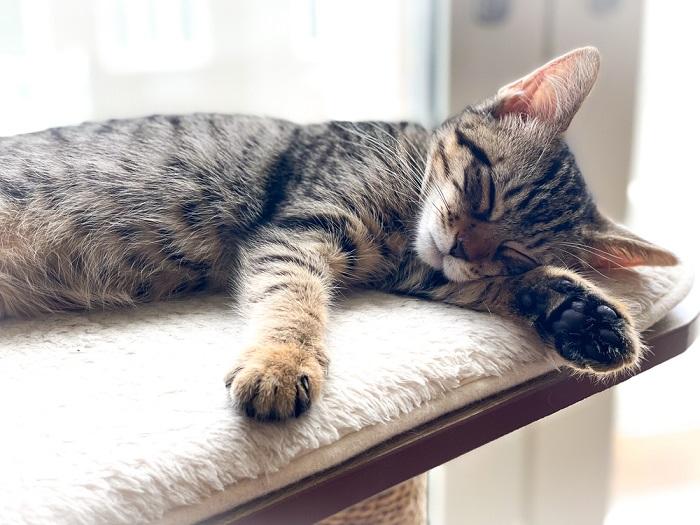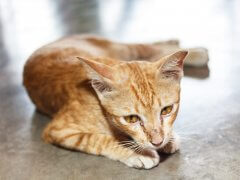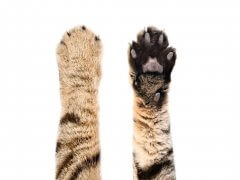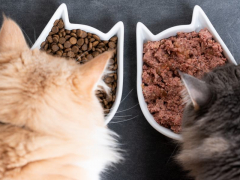
This article aims to explain the details of the issue of low blood pressure (also known as hypotension) in cats in an easy-to-understand way for cat owners.
What Is Low Blood Pressure?
The normal blood pressure of a cat should be between 120 to 140 mm Hg systolic blood pressure and 70 to 90 mm Hg diastolic blood pressure, with a mean of around 110 mm Hg. Hypotension means that the blood pressure is lower than these levels. (Hypertension, or high blood pressure, would mean that the blood pressure was higher than these levels).
How Is Blood Pressure Measured in Cats?
There are three ways that blood pressure measurements can be taken from cats.
Direct
The most direct way of measuring cat’s blood pressure is to insert a catheter directly into an artery. The catheter, then connect this to a pressure measuring device.
However this requires sedation or anesthesia, it’s technically challenging, and there are risks involved, so it’s rarely carried out in this way. Instead, so-called indirect methods of measuring blood pressure are used.
Indirect
The most popular systems for indirectly measuring blood pressure are Doppler sphygmomanometry and oscillometric measurement.
Doppler
The Doppler method (which closely resembles the traditional inflatable arm cuff and stethoscope method used by human doctors) works by detecting the flow of blood past a pressurized cuff attached to a manometer (a pressure measurement gauge).
In practice, fur is clipped over an area of skin overlying an artery (usually the paw, or the tail), and ultrasound gel is placed on the skin. The Doppler sensor device is placed on top of this area, and an inflatable cuff is placed around the limb (or tail) between the clipped area and the body.
The hissing sound representing blood flow can be heard initially (either via headphones or a loudspeaker) and then as the cuff is inflated, the sound eventually stops (when the pressure applied by the cuff is greater than the systolic blood pressure).
The pressure in the cuff is gradually reduced by releasing air, and when the sound of blood flow can be heard again, this indicates the systolic blood pressure. This method is not an accurate way of measuring the diastolic blood pressure.
Oscillometric
The oscillometric method uses computer technology to measure the oscillations of the artery under an inflated cuff: a single cuff both occludes the arteries and also senses the blood flow in the blood vessels.
The cuff is inflated to higher than systolic pressure, and then deflates slowly. As the cuff pressure decreases below systolic pressure, blood starts flowing through the artery and causes oscillations that can be detected.
These are converted into an electronic signal by a transducer, and a microprocessor then uses an algorithm to determine systolic, diastolic, and mean arterial pressures. The blood pressure monitor machines that carry out these measurements are largely automated, so this method is a convenient way of monitoring blood pressure during anaesthesia and surgery.
This method, however, is less accurate when measuring the blood pressure of cats with hypotension.
How Common Is Low Blood Pressure?

Low blood pressure (hypotension) is less common than high blood pressure, and is generally is a problem that’s seen as a secondary complication to other underlying disease issues.
High blood pressure (hypertension) is a more common issue in cats that may seem otherwise healthy. This often develops secondary to other medical conditions e.g. older cats with high thyroid hormones (hyperthyroidism), Cushing disease, renal disease, obesity, etc.
Feline hypertension can also develop secondary to excessive fluid therapy. Secondary hypertension is more common than primary hypertension. Both types of hypertension can lead to serious side effects, including retinal detachment leading to acute blindness.
Low blood pressure (hypotension) is less common than high blood pressure and is generally a problem that’s seen as a secondary complication to other underlying disease issues.
Causes of hypotension include trauma, loss of a significant amount of blood, anemia, shock, acidosis, kidney failure, hypothermia (chilling), bradycardia (slow heart rate), heart failure or prolonged anesthesia.
Low blood pressure is a condition that is more likely to be seen in a critical care environment (i.e. a cat being treated by a vet for other issues) than a cat in a home setting.
One exception to this is when a cat with high blood pressure is given too much medication to lower blood pressure (e.g. amlodipine) which then can cause too much of a reduction in blood pressure i.e. hypotension.
How Do Cats Get Low Blood Pressure?
Low blood pressure develops when a cat’s body is under stress because of a primary problem of some kind, as mentioned above. The physiological reaction of the cat’s nervous system and vascular system is to reduce the blood pressure to try to stabilize a body under stress with another underlying disease issue.
Symptoms of Low Blood Pressure in Cats

If you’ve seen your cat vomiting, you need to identify the cause and then care for them accordingly.
Clinical signs associated with low blood pressure are often not specific, including weakness, non-responsiveness, disorientation and other signs that the cat is not “normal”. It is not possible to diagnose blood pressure by observing or examining a cat: specific blood pressure measurements need to be taken.
Causes of Low Blood Pressure in Cats
The most common causes are:
- Trauma
- Loss of a significant amount of blood
- Anemia
- Shock
- Acidosis
- Kidney failure or chronic kidney disease
- Hypothermia (chilling)
- Bradycardia (slow heart rate)
- Heart failure
- Prolonged anesthesia
- Overdose with medication for hypertension (e.G. Amlodipine) or heart disease (e.G. Diuretics)
Diagnosis of Low Blood Pressure
If your DVM veterinarian suspects that your cat may have low blood pressure, the following steps may be taken.
1. Detailed History Taking
Your vet will discuss every aspect of your cat’s life and health care. There are other causes of the same types of signs as low blood pressure, and this history will help to differentiate the various possible causes.
2. Physical Examination
Your veterinarian will check your cat over carefully, noting any physical signs of illness, ruling out other causes of the signs that are being shown (e.g. heart disease, poisoning, etc).
3. Routine Blood Tests
It’s likely that your veterinarian may also carry out other blood work, including the usual panel of diagnostic tests, such as hematology (blood count) and biochemistry profiles, to confirm that there is no other underlying cause making your cat ill.
4. Specialised Blood Tests
Tests such as measuring thyroid hormone levels may be carried out in cats suspected of having blood pressure issues. Measurement of electrolytes (including ionized calcium) and acid-base status may be recommended.
5. Other Tests:
The obvious, and definitive, test is to measure your cat’s blood pressure using one of the methods listed above.
Radiography (x-rays) and ultrasound may be carried out, as well as electrocardiography (ECG) to assess your cat’s cardiac function
Urinalysis may also be carried out. Your veterinarian will advise you on whether or not such detailed investigations are indicated.
How Much Does It Cost To Treat a Cat With Low Blood Pressure?
It’s very likely that your cat will have a range of other problems as well as low blood pressure. It is impossible to estimate the treatment cost, as there are so many possible factors going on in the background of individual cases.
You should ask your veterinarian for a detailed estimate before agreeing to proceed with any treatment.
Treatment for Low Blood Pressure

Treatment for low blood pressure is very broad, generally focussing on addressing the primary problem which has led to low blood pressure.
Measures may include:
- Treating shock, including intravenous fluid therapy
- Treating hypothermia, warming the patient up carefully
- Treating electrolyte abnormalities
- Addressing any cardiac issues
- Specific medication such as dopamine, dobutamine, norepinephrine and vasopressin may be suggested
Monitoring and Prognosis
Blood pressure should be monitored regularly using one of the methods mentioned above until the hypotension has fully resolved.
Conclusion
Low blood pressure is a medical emergency that is usually identified by veterinarians treating cats who have other conditions that are ongoing. This is not a condition that would be diagnosed or treated at home without detailed professional veterinary supervision and monitoring.
Frequently Asked Questions
What can cause low blood pressure in cats?
Low blood pressure is usually seen as a secondary problem in a range of illnesses, including
- Trauma
- Loss Of A Significant Amount Of Blood
- Anemia
- Shock
- Acidosis
- Kidney Failure Or Chronic Kidney Disease
- Hypothermia (Chilling)
- Bradycardia (Slow Heart Rate)
- Heart Failure
- Prolonged Anesthesia
- Overdose With Medication For Hypertension
What are the symptoms of hypotension in cats?
Symptoms of low blood pressure include weakness, non-responsiveness, and disorientation. It is not possible to diagnose blood pressure by observing or examining a cat: specific blood pressure measurements need to be taken by your DVM veterinarian.







